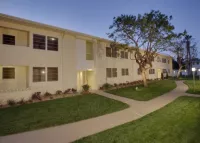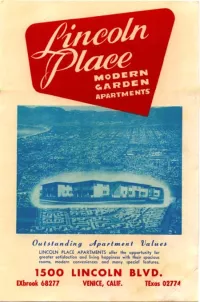Share what you know,
and discover more.
Share what you know,
and discover more.
Mar 08, 2022

-

- Charmaine Bantugan
Lincoln Place
Completed in 1951 by architect Heth Wharton and pioneering African-American designer Ralph Vaughn (both of whom also designed Chase Knolls Apartments in Sherman Oaks and North Hollywood Manor), Lincoln Place was the largest development in California financed under a historic mortgage insurance program administered by the Federal Housing Administration (FHA). Developers Philip Yousem and Samuel Bialac leveraged the development of Lincoln Place Apartments with an FHA mortgage, which demanded value for its investments in quality architectural design. The buildings at Lincoln Place are designed in a vernacular modern style, with two-story dwellings and some one-story bungalows. The basic two-story dwellings are clad in stucco, with variations in architectural detailing to provide contrast throughout the complex. Entryways, which contain interior staircases for second floor units, are variously embellished with several configurations of entrance canopies, wood posts, and stairwell windows with frosted glass and custom, diamond-shaped panes. It embodies the Garden City planning principles that the FHA advocated in 1947 for rental housing: multi-family housing units are placed in a garden-like, open setting with common courtyards. Collective parking areas and laundry rooms and rear service entrances stimulate resident interaction and emphasize a sense of community. Spanning thirty-eight acres a mile from the beach in Venice, Lincoln Place is roughly bounded by Frederick Street, Penmar Avenue, Lake Street, and Palms Boulevard. It originally contained 795 units in 52 buildings. In an epic, decade-long battle, including the demolition of ten buildings, the rest of the site was preserved. The owner rehabbed the remaining forty-five historic buildings and constructed thirteen new ones in the place of the ones that had been demolished. The project demonstrates that if done correctly, old and new construction can co-exist harmoniously in garden apartment communities. This extraordinary project earned Lincoln Place a Conservancy Preservation Award in 2015. SIGNIFICANCE: The creation of Lincoln Place responded to significant developments in national housing needs and the planning of Los Angeles. The end of World War II and the creation of the G.I. Bill precipitated a widespread housing shortage in the United States, with few private companies creating rental apartments for low to moderate-income families. The Santa Monica Bay area felt this pinch acutely as the location of Douglas Aircraft’s plant in 1940 and the opening of Los Angeles Airport in 1947 increased housing demand on the Westside. To address the housing shortage, the Federal Housing Authority (FHA) created a mortgage insurance program, whose low cost of lending and liberal valuation of land would encourage developers to meet this housing need. Photo courtesy of AIMCO
Lincoln Place
Completed in 1951 by architect Heth Wharton and pioneering African-American designer Ralph Vaughn (both of whom also designed Chase Knolls Apartments in Sherman Oaks and North Hollywood Manor), Lincoln Place was the largest development in California financed under a historic mortgage insurance program administered by the Federal Housing Administration (FHA). Developers Philip Yousem and Samuel Bialac leveraged the development of Lincoln Place Apartments with an FHA mortgage, which demanded value for its investments in quality architectural design. The buildings at Lincoln Place are designed in a vernacular modern style, with two-story dwellings and some one-story bungalows. The basic two-story dwellings are clad in stucco, with variations in architectural detailing to provide contrast throughout the complex. Entryways, which contain interior staircases for second floor units, are variously embellished with several configurations of entrance canopies, wood posts, and stairwell windows with frosted glass and custom, diamond-shaped panes. It embodies the Garden City planning principles that the FHA advocated in 1947 for rental housing: multi-family housing units are placed in a garden-like, open setting with common courtyards. Collective parking areas and laundry rooms and rear service entrances stimulate resident interaction and emphasize a sense of community. Spanning thirty-eight acres a mile from the beach in Venice, Lincoln Place is roughly bounded by Frederick Street, Penmar Avenue, Lake Street, and Palms Boulevard. It originally contained 795 units in 52 buildings. In an epic, decade-long battle, including the demolition of ten buildings, the rest of the site was preserved. The owner rehabbed the remaining forty-five historic buildings and constructed thirteen new ones in the place of the ones that had been demolished. The project demonstrates that if done correctly, old and new construction can co-exist harmoniously in garden apartment communities. This extraordinary project earned Lincoln Place a Conservancy Preservation Award in 2015. SIGNIFICANCE: The creation of Lincoln Place responded to significant developments in national housing needs and the planning of Los Angeles. The end of World War II and the creation of the G.I. Bill precipitated a widespread housing shortage in the United States, with few private companies creating rental apartments for low to moderate-income families. The Santa Monica Bay area felt this pinch acutely as the location of Douglas Aircraft’s plant in 1940 and the opening of Los Angeles Airport in 1947 increased housing demand on the Westside. To address the housing shortage, the Federal Housing Authority (FHA) created a mortgage insurance program, whose low cost of lending and liberal valuation of land would encourage developers to meet this housing need. Photo courtesy of AIMCO
Mar 08, 2022
Lincoln Place
Completed in 1951 by architect Heth Wharton and pioneering African-American designer Ralph Vaughn (both of whom also designed Chase Knolls Apartments in Sherman Oaks and North Hollywood Manor), Lincoln Place was the largest development in California financed under a historic mortgage insurance program administered by the Federal Housing Administration (FHA).Developers Philip Yousem and Samuel Bialac leveraged the development of Lincoln Place Apartments with an FHA mortgage, which demanded value for its investments in quality architectural design.
The buildings at Lincoln Place are designed in a vernacular modern style, with two-story dwellings and some one-story bungalows.
The basic two-story dwellings are clad in stucco, with variations in architectural detailing to provide contrast throughout the complex. Entryways, which contain interior staircases for second floor units, are variously embellished with several configurations of entrance canopies, wood posts, and stairwell windows with frosted glass and custom, diamond-shaped panes.
It embodies the Garden City planning principles that the FHA advocated in 1947 for rental housing: multi-family housing units are placed in a garden-like, open setting with common courtyards. Collective parking areas and laundry rooms and rear service entrances stimulate resident interaction and emphasize a sense of community.
Spanning thirty-eight acres a mile from the beach in Venice, Lincoln Place is roughly bounded by Frederick Street, Penmar Avenue, Lake Street, and Palms Boulevard. It originally contained 795 units in 52 buildings. In an epic, decade-long battle, including the demolition of ten buildings, the rest of the site was preserved.
The owner rehabbed the remaining forty-five historic buildings and constructed thirteen new ones in the place of the ones that had been demolished. The project demonstrates that if done correctly, old and new construction can co-exist harmoniously in garden apartment communities. This extraordinary project earned Lincoln Place a Conservancy Preservation Award in 2015.
SIGNIFICANCE:
The creation of Lincoln Place responded to significant developments in national housing needs and the planning of Los Angeles. The end of World War II and the creation of the G.I. Bill precipitated a widespread housing shortage in the United States, with few private companies creating rental apartments for low to moderate-income families.
The Santa Monica Bay area felt this pinch acutely as the location of Douglas Aircraft’s plant in 1940 and the opening of Los Angeles Airport in 1947 increased housing demand on the Westside. To address the housing shortage, the Federal Housing Authority (FHA) created a mortgage insurance program, whose low cost of lending and liberal valuation of land would encourage developers to meet this housing need.
Photo courtesy of AIMCO
Posted Date
Mar 08, 2022
Historical Record Date
Mar 08, 2022
Source Name
Los Angeles Conservancy
Source Website
Delete Story
Are you sure you want to delete this story?











